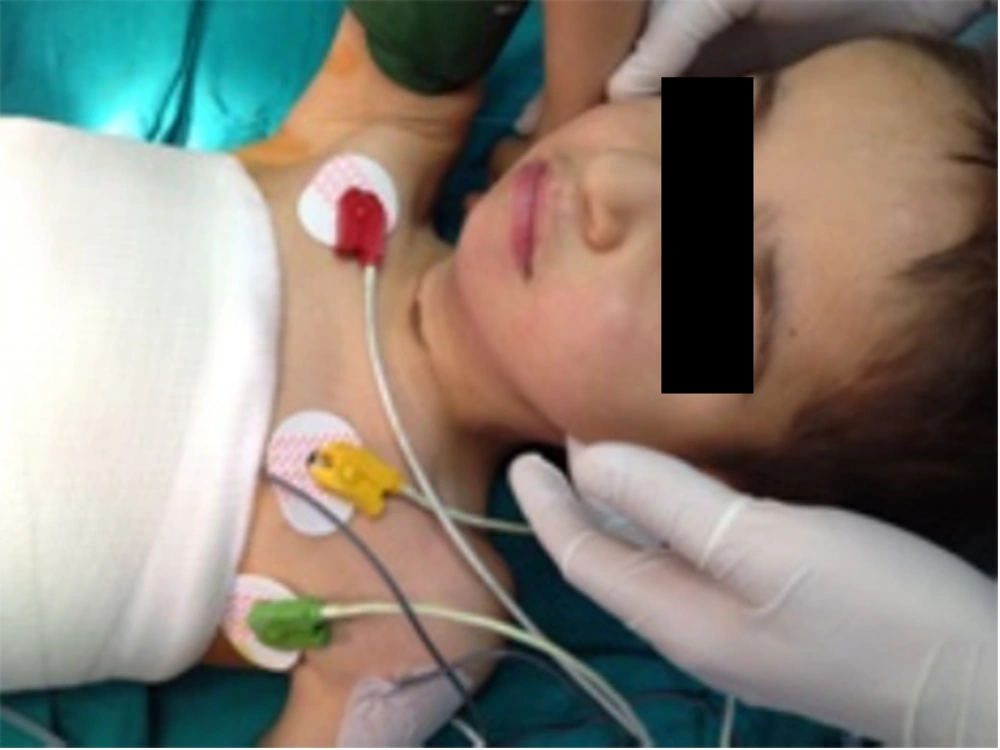Dear Editor,
Pierre-Robin Syndrome (PRS) is characterized by micrognathia, glossoptosis, and a “u-shaped” cleft palate (1). The incidence of PRS varies from 1: 5000 to 1: 85000 (2). Neonates with PRS present with respiratory obstruction varying from mild to severe directly after birth or during the first week of life. A sufficiently severe obstruction can result in obstructive apnea, hypoxia, failure to thrive, and death (3). We report a case of a patient with PRS who could not be intubated previously and who had a history of tracheostomy; this patient was scheduled to undergo an operation for hip dysplasia. We present our anesthesia management and approach. An 8-year-old boy weighing 18 kg and diagnosed with PRS underwent preoperative evaluation that revealed restricted mouth opening, micrognathia, short extremities, mild airway obstruction, and respiratory distress (Figure 1).
His Mallampati score was 3, his head-neck extension was comfortable, and his thyromental distance was within the normal range. Preoperative laboratory and imaging tests yielded normal results. This patient had a history of difficult intubation, and tracheostomy preparations were made to allow for a difficult intubation. The patient had no other known diseases and conditions that contraindicated spinal anesthesia (SA). Preoxygenation was performed under routine monitoring. The patient’s baseline heart rate was 131 beats min-1, his blood pressure was 112/64 mmHg, and his SpO2 was 94%. Premedication and amnesia treatment consisted of administration of 10 mg midazolam (Dormicum, Roche, Istanbul, Turkey) intranasal 10 minutes prior to the procedure. The patient was then administered 2 mg/kg propofol, 25 µg fentanyl (Talinat, Vem Ilac, Istanbul, Turkey), and 40 mg methylprednisolone (Prednol-l, Mustafa Nevzat, Istanbul, Turkey) intravenously. A no. 2.0 I-gel was placed while the patient was in the supine position, and the patient was then placed in a lateral decubitus position. The skin was prepared with antiseptic and a spinal block was carried out by administering 0.4 mg/kg hyperbaric bupivacaine to the L4-5 vertebral space, as described previously (4) (Figures 2 and 3).
After the procedure, the patient was placed in a supine position. Muscle relaxants were not used during surgery and anesthesia was maintained with 100 µg/kg/min continuous propofol infusion. The operation lasted for two hours. Spontaneous respiration was sufficient at the end of the operation and the patient was extubated and transferred to the recovery unit. In follow up, active extremity movements started and the patient was transferred to the orthopedics clinic. Micrognathia may be an isolated problem or may occur as part of a sequence or a syndrome such as PRS (5). Patients with PRS have a high risk of airway obstruction and a high probability of the development of malnutrition, failure to thrive, hypoxemia, cor-pulmonale, loss of strength, and cerebral anoxia. In these patients, respiratory problems lead to aggravation of the clinical picture. Airway obstruction is caused by the presence of glossoptosis, in addition to cleft palate and micrognathia with retrognati (6). The small size and backward position of the jaw in children with PRS create serious difficulties in using a mask and maintaining an open airway in the supine position. The airway obstruction risk will increase when the soft tissues are relaxed; therefore, the use of muscle relaxants should be avoided (7). No problems were encountered with mask use in our case, so an I-gel was placed under propofol anesthesia without using any muscle relaxants, and a spinal block was carried out for postoperative analgesia.
The intubation and extubation of PRS cases requires special care, and preoperative monitoring is warranted. For operations under the umbilicus, regional anesthesia can be a good alternative in children who are at high risk from general anesthesia (8). In fact, previous studies have demonstrated that regional anesthesia is a safe alternative in neonates (9). In our opinion, preparations should be made for difficult airway management in these cases, and spinal anesthesia may be reliably and safely used in lower extremity surgeries.


